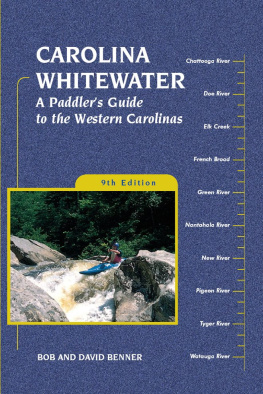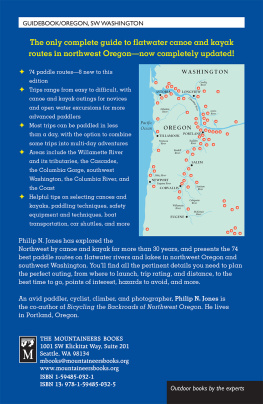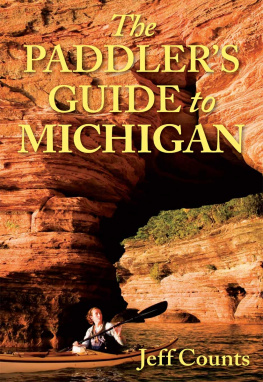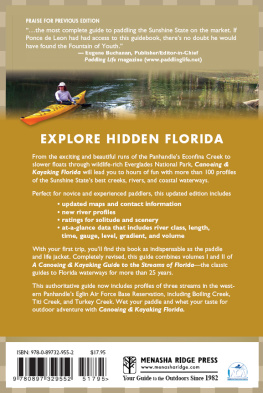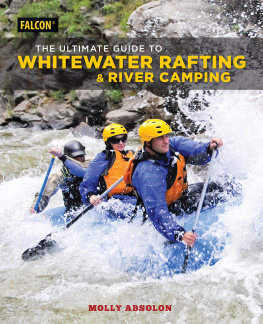
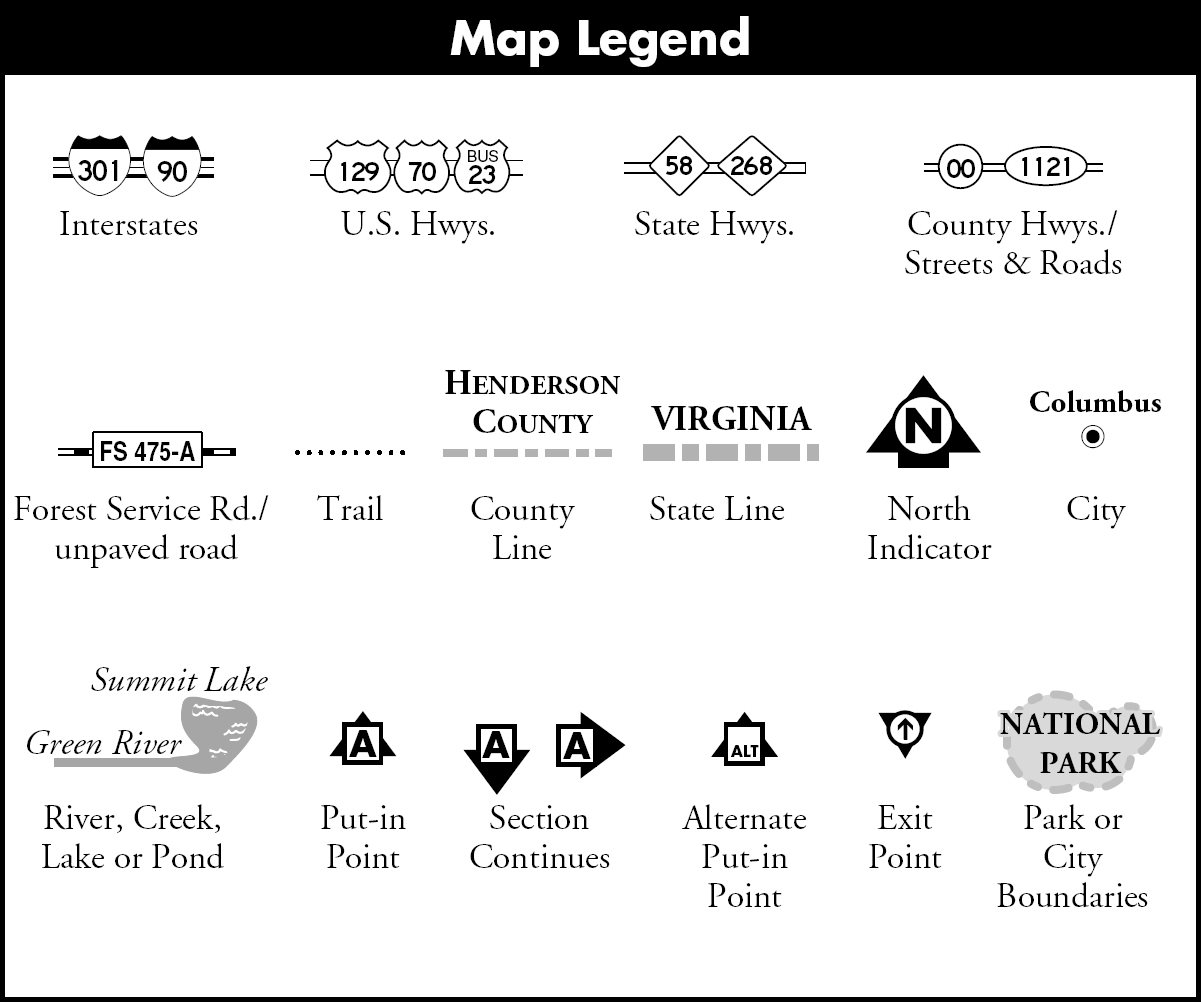
Once there was a legend that told of a river that went to hear a fountain sing. The song was so beautiful that the river decided to sing it to the ocean. All the way to the shores of the ocean the river sang. Soon, the mountains heard of the song that the river was singing and came from all over the land to listen. And because the song was so beautiful the mountains settled down and stayed to listen forever.
Algonquin Indian Legend
Dedicated to Ramone Eaton
A man who canoed as he livedwith grace and charmlaid his paddle to rest on April 25, 1980. It will be a while before another like him will paddle with us.

Copyright 1981, 1987, 1993, 1998, 2002, 2005 by Bob Benner and David Benner
All rights reserved
Published by Menasha Ridge Press
Distributed by Publishers Group West
Printed in the United States of America
Ninth edition, first printing
Library of Congress Cataloging-in-Publication Data
Benner, Bob.
Carolina whitewater: a paddlers guide to the Carolinas / Bob Benner and David Benner. 9th ed.
p. cm.
Rev. ed. of: A canoeing and kayaking guide to the Carolinas. 8th ed. 2002
Includes index.
ISBN 978-0-89732-617-9
1. Canoes and canoeingNorth CarolinaGuidebooks. 2. Canoes and canoeingSouth CarolinaGuidebooks. 3. KayakingNorth CarolinaGuidebooks. 4. KayakingSouth CarolinaGuidebooks. 5. North CarolinaGuidebooks. 6. South CarolinaGuidebooks. I. Benner, David, 1955 II. Benner, Bob. Canoeing and kayaking guide to the Carolinas. III. Title.
GV776.N74B46 2005
917.56dc22
2005041567
Cover photo: Copyright David Benner
Cover design: Bud Zehmer
Text design: Ann Marie Healy
Photos on by David Benner.
Photo on by .
Menasha Ridge Press
P.O. Box 43673
Birmingham, Alabama 35243
www.menasharidge.com
The authors will appreciate any pertinent comments, corrections, or suggestions which might prove valuable in any future editions.
DISCLAIMER
While every effort has been made to insure the accuracy of this guidebook, river and road conditions can change greatly from year to year. This book is intended as a general guide. Whitewater paddling is an assumed-risk sport. The decision to run a river can be made only after an on-the-spot inspection, and a run should not be attempted without proper equipment and safety precautions. The authors and publisher of Carolina Whitewater: A Paddlers Guide to the Western Carolinas are not responsible for any personal or property damage that may result from your activities. By using any part of this guide, you recognize and assume all risks and acknowledge that you are responsible for your own actions.
Maps
Acknowledgments
The authors would like to acknowledge the many people whose assistance made such an undertaking possible. There are so many, too numerous to mention, who have lent a helping hand in some way or another. A few whose efforts require a special note of thanks are: members of the Blue Ridge Outing Club and the Carolina Canoe Club for providing invaluable feedback for the new edition, Vann and Laura Evans for their notes on the Haw River, Leonard Baker and R. B. Binegar for their willingness to go well beyond the call of duty, and Donna Benner for her patience in typing the work in progresslittle pay but many thanks.
And last, but certainly not least, we wish to thank our many friends for joining in interesting exploratory trips, even as they undoubtedly questioned the advisability of the friendship when such trips turned into hikes down dry streambeds, ice breakers, and major engineering featsbut always turned into memorable outings. We are deeply indebted to Steven Hughes. With the addition of many creek runs, Steven has made a very significant contribution towards keeping this guidebook fresh and relevant. Kudos to the man!
Introduction
This guide, originally written for the recreational open boater, has been expanded to include stretches of water that will challenge the most advanced decked canoe and kayak paddler. Much of the water, however, is suitable for the novice paddler. The more difficult runs are not recommended for those thrill seekers who wish to try their wings. Ones wings need to be fully grown before attempting these highly technical, and quite often dangerous, stretches. In classifying rapids it is difficult to remain totally objective because judgment is generally relative to experience.
As the sport of paddling grows, more and more clubs are being organized with paddling as their main interest. Some longtime paddlers question the need for such growth or organization, and rightly so, but this is one of the few safe proving grounds available for aspiring paddlers. It is primarily through clubs that paddlers can obtain competent instruction to improve skills and learn safe paddling practices. Also, it is only by organization that our free-flowing rivers are going to be saved for future generations.
Information on safety has been included because of certain hazards involved in the sport. Hopefully the suggestions made will lessen the possibilities of accidents other than normal swampings and dunkings.
Along with these suggestions are rules that will be helpful for the paddler who decides that Labor Day shouldnt necessarily mean the end of the season. More and more paddlers are venturing forth in the middle of winter to experience a completely different world. The risks increase as the air and water temperatures decrease. A familiarity with certain facts relating to exposure can cut down considerably on these inherent risks.
The average paddler in North Carolina seems to harbor the idea that one has an inalienable right to paddle on any stream that has enough water to float a canoe. This most certainly is a misconception under the present interpretation of state law, and an attempt to clarify what the rights of the paddler may be is discussed.
An explanation of the books overall format has been included so that the reader can fully understand the organization of the materials on the streams and the various sections into which they may be divided. In Canoeing White Water, Randy Carter established such an understandable outline in describing rivers that it has been followed very closely.
This book is organized into six chapters. The first four consist of groups of rivers in neighboring counties in the foothills and mountains of the state: these are further grouped by watershed. The fifth chapter contains the Chattooga, the Chauga, the Doe, and the Tyger, located in neighboring states. The Haw River, a stream of the Piedmont, has also been included because of its extreme popularity. The last section has very little whitewater but has been included to offer the paddler a selection of some 200 miles suitable for camping trips.
Though the maps included is this ninth edition of Carolina Whitewater are as accurate as any can be (they are based primarily on county road maps), some amount of error is to be expected. Using these maps in conjunction with county maps will help you set shuttles quickly and accurately.
The original reason for undertaking such a work as this was to provide a source of information for those who would like to take their pleasure in paddling the many beautiful rivers of the western Carolinas. The effort will have been worthwhile if any small portion of the great pleasure the authors have experienced on the several hundred miles described herein is imparted to the reader.
Next page
